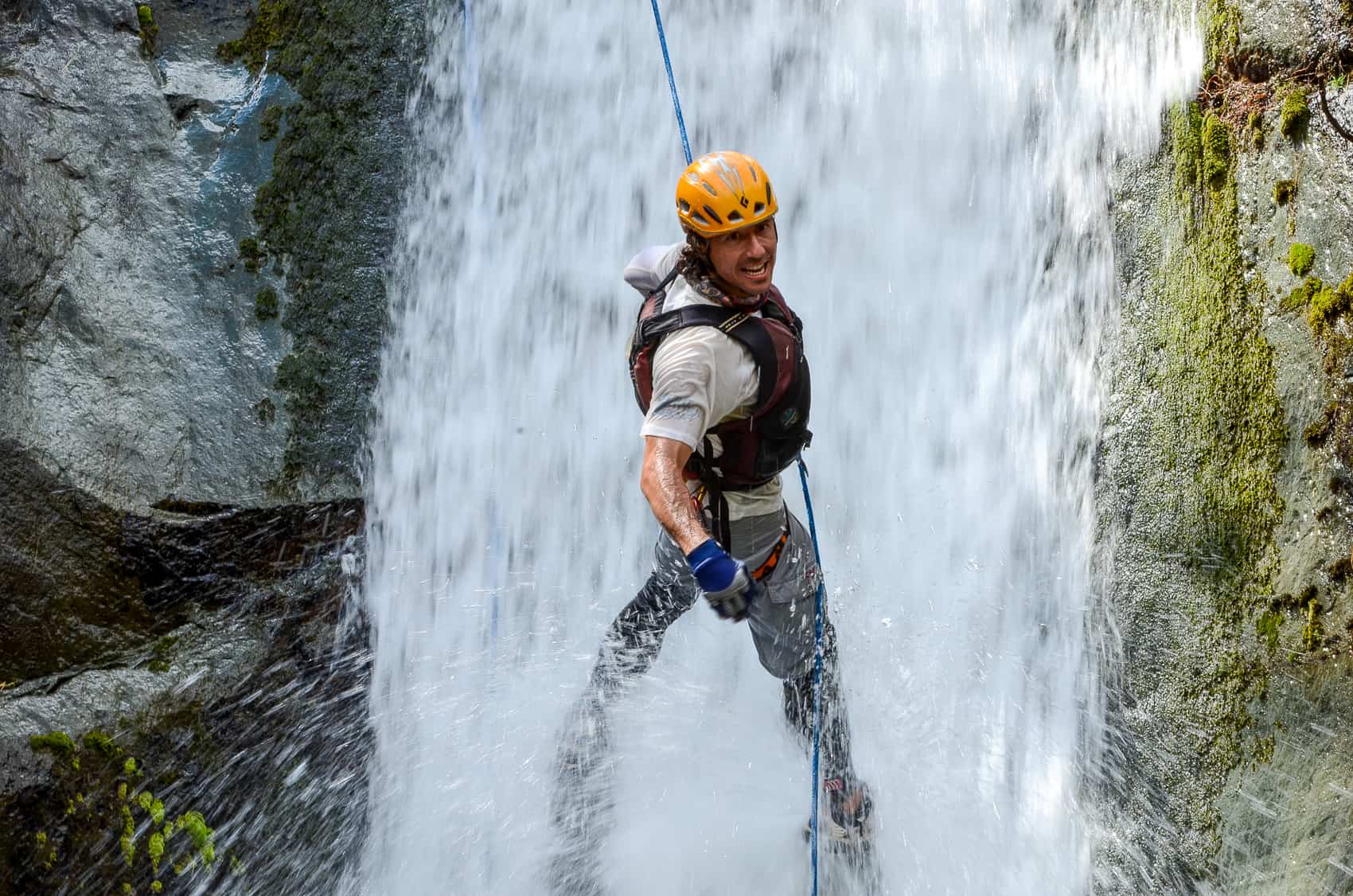With a little hop, Felipe López Pozuelo started to climb the tree. He groped the curtained bark and pulled himself upward. He planted his feet in a pair of notches, felt along the tree with his fingers, then hauled his lithe body a few inches higher. With each small advance, López caressed the smooth texture of the tree, as if trying to sculpt its surface. A nylon rope extended from his belt and bobbled around him. When López found two branches, splayed outward like a wishbone, he slowly grasped them, then released his legs from the tree. He hung there, legs pedaling the air, as he decided his next move.
“Muy bien, mae,” called Eduardo Baldioceda Baltodano from below. Baldioceda wore a harness around his waist, through which slithered the belaying rope. Each time López ascended, Baldioceda drew the line through his carabineer, making it taut. He shouted words of encouragement in Spanish and English: “Tuanis, mae! You got it! Awesome!”
López seemed weightless as he levitated his way up the tree. When he reached the top, he tapped the colored casing that signified the end of the belay. Then he leaned back, arms outstretched, and the small crowd below began to clap and holler.
“Nice!”
“Buenísimo!”
“Qué bonito, mae!”
Baldioceda beamed as he slackened the line, and his business partner descended from the tree, floating back to the ground. When they met, Baldioceda and López high-fived and pounded fists, but the gesture was loose and easygoing. Climbing the tree was a nice demonstration; López’s movements were especially fluid this morning, freshly fueled by coffee and gallo pinto. Yet for the two 38-year-old sportsmen, this is just a typical morning at La Chakra Tent Camp. It is literally a walk in the park.
“Okay, who wants to go next?” said Baldioceda, rubbing his hands together. He surveyed the squad of people gathered around him. It was a random handful: Two Proctor & Gamble employees, two architects, one guy who worked in construction, one recent high-school graduate, and two reporters from The Tico Times. The group was scattered around – crouched on the ground, perched on a moist log, or anxiously standing near the bushes.
López jutted his chin. “Robert, you want to go first?”
I felt a smile break across my face. “Sure,” I said. And I stepped forward to accept the harness.
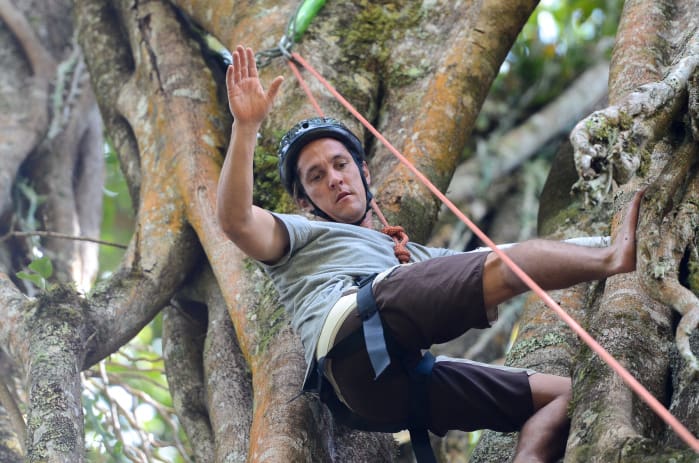
If you flew a prop plane over Chakra, you wouldn’t even notice it. The 12-hectare property is nestled in a heavily forested valley, and most of Chakra lies along a steep slope covered in green vegetation. To reach the private reserve, you have to drive the Pan-American Highway past San Isidro del General, take a left onto a paved road, then continue when the asphalt turns to gravel.
You coast through a tiny hill town called San Jerónimo, then continue along a rugged road that snakes along the river valley. This road is as primitive as they come; the toughest SUV hobbles along at 10 kilometers per hour, thumping over piles of rocks and deep trenches. When you reach the end of this road, you find Chakra, but no sign or landmark tells you that you’re there. Even by Costa Rican standards, Chakra is extremely remote, which is exactly how Baldioceda and López like it.
Until recently, Chakra – and the town of San Jerónimo, and the entire valley – have been an obscure point on a map. Few backpackers would bother to venture this way, much less stay in a sleepy village of concrete cottages. The only major industry here is coffee, and terraced coffee groves carpet the valley’s sides. For centuries, the “mountain people” have lived hardscrabble lives among these rugged tors, gradually wearing trails into the soil by trekking and riding horses from one peak to the next.
“They’re tough cookies,” Baldioceda told me, shaking his head in wonder. “They’re very quiet. I had dinner with a family in the mountains, and they didn’t say a word. Not one word.”
But something is about to happen in San Jerónimo that could change the entire region. After three years of petitioning, local leaders have won permission to lead hikers into the mountains – all the way to the summit of Chirripó, Costa Rica’s tallest peak.
In March, San Jerónimo will open itself to hikers from around the world. Local families will host backpackers. Local businesses will feed and equip them. Veteran farmers will organize tours and guide visitors into the national park. San Jerónimo could become the next ecotourism hotspot, just because of its proximity to the new trailhead.
Farther up the hill, a stone’s throw from the park entrance, stands Chakra. The so-called tent camp is the “end of the road,” as López and Baldioceda like to say. To reach the new Chirripó route, hikers will have to cross their property on that same weather-beaten road. Travelers are about to flock to this remote valley, and the two friends will have to decide how to welcome them.
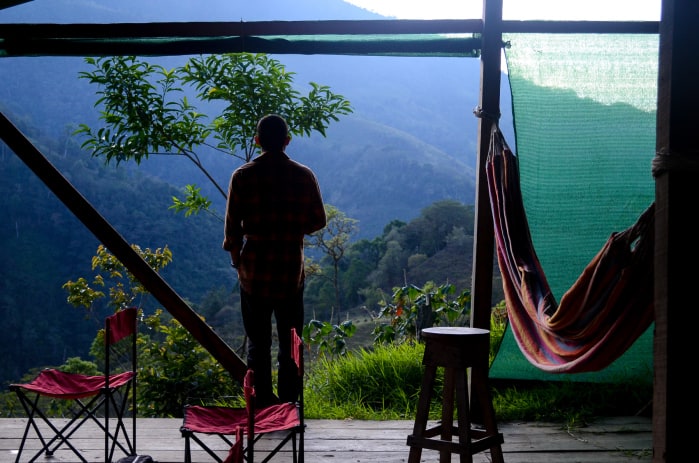
I was wary, because I hadn’t climbed a tree since I was a kid. More importantly, there was no tree in my New England childhood that was quite like this. The “strangling fig” looked like a mass of petrified tentacles that twisted upward, blossoming into branches and foliage toward the top.
The tree is a malevolent beauty: It begins its life as a series of vines that gradually wrap around another mature trees, then “strangle” the life out of it. Over the course of decades, the fig engulfs its prey, until the first tree disintegrates, leaving a hollow space inside the fig. The resulting tree has a chthonic appearance; the tendrils are as gray and hard as slate.
I touched the tree, weighed the options, and finally lifted myself upward. I am a densely built 35-year-old, neither fat nor skinny, and my once powerful arms have atrophied over time. But I still managed to push myself upward, remembering not to flex my biceps any more than necessary, to lean on my legs whenever possible. I felt the belay rope tugging at my harness, assuring me that no matter what happened, I was secure. Even if I slipped unexpectedly, Baldioceda would tighten the rope and I would fall no more than a meter.
When I reached the low, dead branches, I managed to shimmy between them without a problem. I stood up straight and rested against the tree trunk, then took in the view. The mountains rolled all around us. I could hear the river sizzling through the woods nearby. I could see the bald hill of a cow pasture. The valley embraced us in its dense timberland, shaded dark green beneath a brilliant morning sun.
We always hear about the variety of Costa Rica’s life forms, but gazing on those walls of land, I could believe that five percent of the world’s biodiversity lives here: No two trees looked quite the same, each boasting a different height, color, and foliage. Some were speckled with flowers, others bloomed with fruit. Some trees grew above the canopy, their naked trunks extending into the open air, until a pompom of leaves bundled at the top. Growing up in temperate Vermont, I once pictured the jungle as an endless blanket of palm trees, but Costa Rica’s rainforest billows robustly, like a sea of lichen.
“Come on, Robert, you’re almost there!” Baldioceda urged.
I continued the climb, but when I reached a particularly smooth surface, I frowned at the lack of handholds. There was nowhere I could go. My arms burned with lactic acid. I had warned Baldioceda that this was what always happened to me – I started strong, but I burned out quickly. My leaden forearms disappointed me. I could picture myself losing my grip, falling away from the tree trunk and swinging through the air, a dangling failure.
“Just a precaution,” I called down. “I might not make it. I’m losing strength.”
“Don’t decide that!” Baldioceda snapped back.
I grimaced. I am not the kind of man who smolders with competitive spirit. But I was the first Chakra guest to climb, the first to reach this height. Seeing those youthful faces below, I knew I was clearly the oldest person here, aside from López and Baldioceda. I felt a surge of energy, a desire to conquer my age. Crevices seemed to emerge in the tree, and I shoved my fingers into them, forcing them to hold. My maneuvers were dirty and desperate, but I managed to scale another meter, then another, until I smacked a palm against the top.
“That’s it!” Baldioceda cried.
The others shrieked and clapped. I relaxed into the rope, letting myself drift through the air. As I swung toward the tree, I pushed myself away with my hiking boots, a vertical moon-bounce. When I reached the forest floor, my arms felt bloodless and my carotid arteries throbbed inside my neck.
One by one, the other visitors climbed the tree. They struggled in different ways. Their ankles trembled. Their arms gave out. Like me, many had to rest on the upper tier, huffing from the exertion. But every single person reached the top.
The last to go was Alberto Font – known to everyone as “Beto”. He is a photojournalist and my colleague at The Tico Times. He is taller and trimmer than I am, and he works out routinely at a gym in San Pedro. But even I was surprised by the way he climbed the tree, gripping invisible nooks with the ease of a squirrel. He scurried to the top, smacked the casing, and rappelled back down.
López cut a watermelon into slices with a massive knife, then offered them to his guests. As we munched the fruit and spat out seeds, Lopez marveled, “Everybody made it. This is a good group, you can tell.”
Later, as we strolled down the road back to Chakra, I struck up conversation with one of the Proctor & Gamble employees. (I’ll call her María.) She was peppy and bright-eyed, and she looked a decade younger than her 32 years. I asked María whether she normally spent time tromping around the woods.
“No, not really,” María said. She had never been rock-climbing, for example. She worked in Santa Ana and lived in San Pedro, and she spent many of her weekdays commuting between the two. “But I’m an apuntada,” she said proudly.
I had never heard the term before. Beto would later explain that apuntado means “signed up,” and when people describe themselves as un apuntado/a, it means that they are eager for new experiences, “signing up” for any activity they can find.
“My brother and sister are apuntados, too,” María added. “But I’m the most apuntada of all of us.”
Contrary to their woodsy demeanors, López and Baldioceda were born city slickers. They grew up in comfortable homes in Escazú, and they graduated from the private Lincoln High School. But unlike their suburban kin, López and Baldioceda are black sheep: They have always loved nature, and their simmering passion for adventure sports has come to a boil over time.
They both attended the Universidad Latina, and they both studied biology. The program was brand-new at the time, and both López and Baldioceda were among the university’s first graduating class of biologists. Because the curriculum was so new, they enjoyed the freedom and flexibility it afforded. For their final theses, Baldioceda did research on jaguars. López studied island bird species.
Both men had the chance to become researchers after university, but they immediately started working in tourism. Biology had enabled them to become skilled naturalists, an essential trait in the ecotourism industry. Baldioceda and López have spent 15 years leading adventure tours, guiding groups all over Costa Rica. In 2009, Baldioceda formed his own company, Real Costa Rica Vacations, and last year López became a partner in the operation.
When Baldioceda first came to this valley in 2008, he had an epiphany. “I had never heard of it,” he told me. “I was in total awe that such a beautiful place existed.”
The Chakra property received its name from the previous owner, an expat who had built a series of shelters on the land. (The pair insists that “Chakra” does not refer to Hindu energy fields, but rather to the Peruvian word for “farm.”) Baldioceda wished to keep the former owner anonymous, insisting that “that’s in the past.”
But ultimately the owner decided to sell the parcel to Baldioceda, who embellished its infrastructure: Today, Chakra has flushing toilets, hot-water showers, a versatile kitchen, filtered water from a natural spring, and a refined composting system.
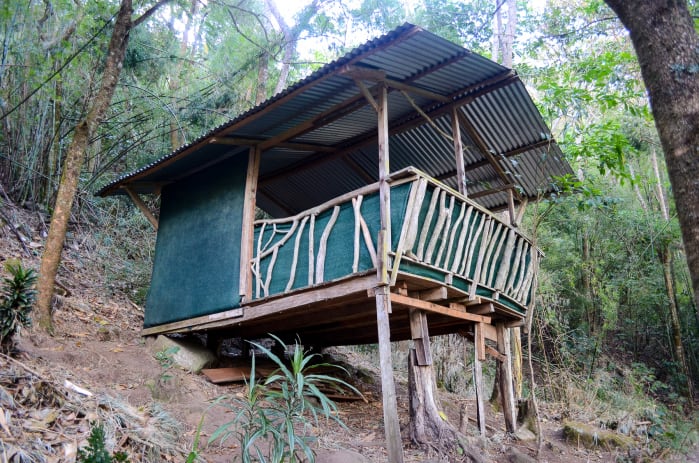
Chakra’s many structures are constructed from weathered lumber, slices of timber, and corrugated metal roofs. The walls are a semi-transparent green gauze, and the windows are open-air. Each structure is more like a lean-to than a cabin, and guests essentially sleep outside, feeling naked breeze and sunshine. Mattresses are spread on the floor, dressed with sheets and a single blanket; I brought a second blanket with me, and the two layers more than sufficed, despite the cool evenings at 1,700 meters (5,500 ft.) above sea level.
Of the two friends, Baldioceda is clearly the alpha dog. With his fiery eyes and raffish smile, Baldioceda bursts with energy at all times. He micromanages every inch of his property, performing every menial task with high intensity. During our weekend at Chakra, Baldioceda cooked multiple meals, washed scores of dishes, then unpacked and utilized and repacked and stored cubic tons of equipment.
I never once saw Baldioceda sleep, or even recline. It is easy to believe that he does multi-day adventure races, and he travels all over the world to compete, from Brazil to South Africa. (His is engaged to Hailey Van Dyk, a Canadian nurse, who is also an accomplished athlete.) Just watching Baldioceda do his thing is exhausting.
López has a gentler presence, but he is no less driven. He is married with two children, and he wears a do-rag printed with photographs of his wife and kids. (“He takes his family wherever he goes,” Baldioceda quipped jovially.) Despite his Buddhist calm, López is also something of a showman: When he finds something funny, he bursts into a high-pitched cackle.
He and Baldioceda like to trade off-color jokes in English and Spanish. At any given moment, López unexpectedly starts singing Latin pop songs, loud and off-key, for his own amusement.
“Don’t be embarrassed,” he told me on the trail.
“Embarrassed? Why?”
“I know I have no talent for singing,” he said. “You don’t have to be embarrassed for me. You don’t have to think, ‘Has nobody told him?’” Then he let fly his manic chortle, which proved infectious.
For two nights and two days, Baldioceda and López flaunted their biological knowledge.
“Have you ever tried guayaba?” López asked me.
I hadn’t, except in juice form. Known in English as “guava,” its concentrate is used to flavor everything from pie to chewing gum, but I had never seen the fruit in real life. The guayaba was like a tiny Golden Delicious apple, but when Lopez bit into it, the meat was the soft red of a watermelon.
“If they’re too yellow, they’re no good,” explained López. “If they’re too green, you will break a tooth. You want them right in the middle.”
To demonstrate, he leapt upward, grabbed a branch, and examined the fruits like a string of pearls. Finally he yanked one from its stem and handed it to me. The taste was subtly sweet, and the stone in the center was like a BB pellet, which I spat into the bushes with élan.
Later, during a quiet moment in the main cabin, Baldioceda stood on the edge of the deck and watched a distant tree through a pair of binoculars.
“There’s a toucanet, right over there,” he whispered excitedly. “Can you see it?”
True to its name, the toucanet looked like a miniaturized toucan, its puffy green body tapering into a curved, pointed beak. As it hopped along the branch, a second toucanet emerged from the leaves. López unveiled a telescope on a tripod and set his site on one of the birds. The two men gazed for long minutes; the excitement froze them in place. I imagined them as students, many years ago, eagerly observing nature and taking down data. After a few minutes, Lopez mentioned that the toucanets might be hunting other birds.
“Wait,” I said. “They’re predators?”
“Not all the time,” said López. “But they will eat almost anything they can find.”
Their shared love for the Chakra property is ebullient. Throughout our stay, López and Baldioceda described their conundrum: On the one hand, they loved inviting people, they loved hosting travelers in their cabinas, and they loved introducing ordinary folks to outdoor activities like tree-climbing. The possibilities of Chakra are endless, they know.
But the land is also pristine, untouched. They can drink directly from the nearby river. This is the calm before the storm. The arrival of mountaineers could help lift the 2,000 people of San Jerónimo out of hard labor and poverty. Yet once the region attracts tourism, there will be no reversing that course.
“Sometimes I don’t want to tell anybody about this place,” conceded López. “I mean, look at it. It’s perfect.”
Climbing Chirripó is a Costa Rican rite of passage: Every Tico with an adventurous spirit has dreamed of bagging its summit. Until now, all Chirripó hikers have started their ascent in San Gerardo de Rivas, a town on the other side of the mountain range.
Although the rates have skyrocketed this year, the routine is always the same: Hikers reserve permits in advance, they spend the night in town, they hike for a full day to the “base camp,” and then they wake in the early morning and summit Chirripó at dawn. Guides are available but not required. No camping or fires are allowed, so the “base camp” is more like an army barracks.
The secondary route through San Jerónimo could change all that. Yes, hikers still need permits. Yes, there is a limited number of permits, to prevent overcrowding. Yes, tents are still prohibited. And unlike on the primary route, hikers from San Jerónimo will be required to hire a guide. But the new trail is leaner, more rugged, and nearly empty.
While Baldioceda and Lpipez have actively lobbied to open the route, they remind me again and again that they are only part of a very large network of advocates: San Jerónimo is home to ATURENA, a cooperative of aspiring guides and tour operators that formed in November of 2007. The group has about 30 members. While the Chakra duo are trained and equipped to lead parties up to Chirripó, there are dozens of others as well.
The San Jerónimo route has existed since time immemorial, but after three years of petitioning by ATURENA, Chirripó National Park and the Environmental Ministry (MINAE) have finally consented to open the route to the public. While both routes lead to the same base camp, the trail from San Jerónimo offers an entirely new terrain, which past hikers have been all but forbidden to explore. This “back way” is much like approaching Mt. Everest from Tibet.
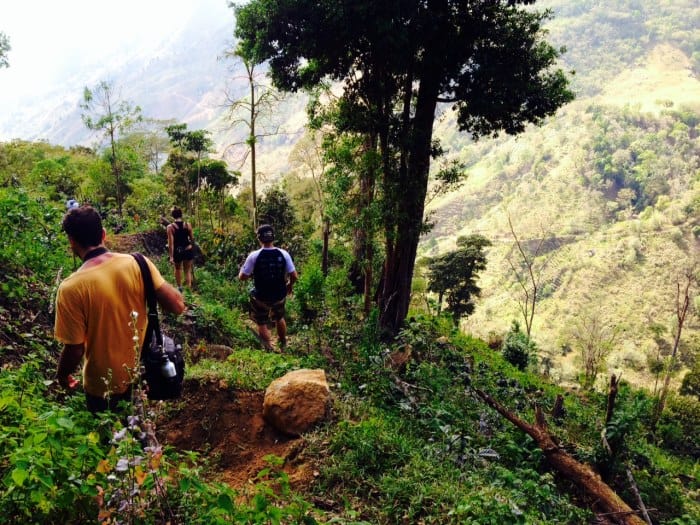
But without the unity of the town, plus thousands of man-hours of hard work and organization, the new route would not exist. And because of its collaborative nature, ATURENA must ensure that all its members get a chance to benefit. When tourists plan their trip, they may not be able to choose their own homestay or guides, even if they know somebody in town. In many ways, ATURENA will behave like a trade union, distributing work to all members.
“I remember when there was only one car on the road,” remembered Luis Elizondo Venegas, an ATURENA member who has lived in San Jerónimo for decades, ever since his home village was ruined by an earthquake. “I think this will be good for the community.”
During our visit, Baldioceda introduced me to Freddy Quirós Piedra, the president of ATURENA. Quirós is a petite, leathery man with a small, elfin voice. Despite his humble appearance, Quiros has hiked throughout the Costa Rican wilderness, and he is legendary for his superhuman endurance.
Baldioceda warned me that Quirós is very shy and might not want to talk much. Surprisingly, we enjoyed a long conversation, and Quirós enthusiastically answered all of our questions. He talked at length about the history of the town and how the new Chirripó route would transform the community.
At last I asked him what kind of tourist he was looking for in San Jeronimo. “There are a lot of different kinds of tourists,” I said. “What are the kinds of people you’re looking for?”
He considered this. “It’s a good question,” he said. “And it’s a difficult question to answer.”
I stood on the edge of the waterfall and affixed my helmet. I tugged at the harness around my hips, then surveyed the horizon. Beyond the 15-meter drop, I saw the valley’s vast escarpments, splayed like a “V” in front of me. Clouds unfurled like silver banners over the dark canopy, carried by cool alpine breezes. Then I glanced down the cliff, where the waterfall poured downward, into a distant pool.
For the past hour, everyone in our group had rappelled down the liquid cascade. They had leaned back 45 degrees, then walked backward down the slick rock face. Baldioceda had preceded every one of them, guiding them with encouraging words. When they reached the final third, and the waterfall rained relentlessly over their legs, Baldioceda told them to swivel around, lie their backs against the rock, and release the rope. Each time, the climber slid down the rope and smashed into the freezing pool below.
Beto had been the first to go. After a couple of tentative steps, he underestimated the slickness of the rock and toppled sideways, dangling from his rope. But then he pulled himself up, spread his feet, and continued down the cliff. He laughed maniacally when he finally let go and disappeared into the dark pool.
I was the last to rappel, and I couldn’t wait. I trembled with excitement.
“Are you ready?” said Baldioceda, fastening himself to the rope.
“Born ready,” I said, smiling smugly.
Baldioceda then paused, looking serious, and said, “You know you can go alone, if you want.”
I returned the gaze, puzzled. “Alone?”
“You look like you know what you’re doing,” said Baldioceda. “During the practice runs, you did really well. I only go down with people to make sure they’re okay, but you clearly have a lot of experience. So if you want to go alone, you can.”
The offer was tempting. The compliment made me lightheaded. Indeed, I had rappelled many times before. My Dad had taken me rock climbing in the Green Mountains when I was only 10 years old, and I had used such rigs, off and on, for years. Baldioceda and Lopez are fastidious about safety, and if he thought I could descend on my own, I felt equally confident.
For a moment I considered this place – Chakra, the settlement at the end of the road, the last lodging before reaching the new Chirripó trailhead. When the route opens in a mere five weeks, San Jerónimo will receive a deluge of new visitors. But the valley won’t suit everyone: Baldioceda and López are hardy guides, and their idea of a morning stroll is to hike for miles into the mountains, tramping up treacherous switchbacks and wandering into isolated vales with no electricity, cell service, or running water.
Although I am in good physical condition, our daylong trek to the 2,200-meter-high San Miguel Valley left me completely exhausted. Exposure to the blinding sun gave me migraines for the rest of the night. Not everyone is willing to eat makeshift burritos in an abandoned shack, or drink from water bottles replenished in a mountain stream.
The people of San Jerónimo know these winding paths like the pronounced veins on the backs of their callused hands, and while Chirripó is no K2, local guides will yearn for adventurous souls – people who like to sweat, to get dirty, to try something they’ve never done before. Chakra is like a good-natured boot camp, where everyone is friendly and welcoming, yet guests should expect extreme physical exertion at any moment. To enjoy this region is to respect its challenging topography.
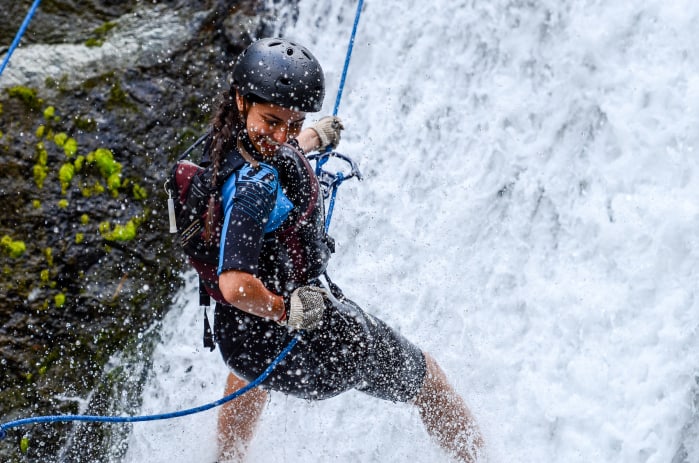
Everyone in our group had done well – the architects, the Proctor & Gamble employees, even the recent high-school graduate. These were exactly the kinds of people who should be here. With any luck, San Jerónimo will receive a steady stream of likeminded folks – healthy, active, and hungry for the chance to test themselves.
Triumphant as I felt, I didn’t want to get cocky. I summoned a grin and said, “It’s been a while since I rapelled regularly. Just for safety’s sake, I’d rather you came with me.”
“Okay, sure,” said Baldioceda, and he nodded toward the cliff’s edge.
First Baldioceda went over its lip, and then I did. I leaned back, spread my knees, and took slow steps down the rock. Frigid water splashed over my shins, soaking my Keens, but after enduring hours of blistering heat, I loved the cold blast. Baldioceda cheated to my left, inviting me to straddle the waterfall.
“Just turn around and go, right?” I called.
“Yeah, exactly!” Baldioceda confirmed.
I spun around on the rope, and my back smacked against the stone wall. Water crashed over my shoulders and head, chilling my muscles. I wanted to bellow with laughter, but the freezing liquid stole my breath. Then I released the rope. My body dropped. For a split second, my skin was flayed by wind and spray; then I slammed into the water.
My first sensation was sound – the muted gurgle of bubbles congregating around my ears. My second sensation was razor-like cold, cutting into every inch of my body. I surfaced, sputtering, but my vocal chords seized.
I sucked rivulets of air into my lungs. The cold was excruciating, but it was a good pain. I slapped my hands on the rocks and hauled myself out of the pool. Water splashed over the pebbles and grass. At last I heard myself emit a high, windy laugh. Just the way an apuntado should.
Robert Isenberg was a writer for The Tico Times. Visit him at robertisenberg.net.

